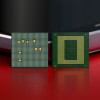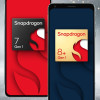Qualcomm Intros Snapdragon 805 Processor, LTE Radio
Nov 20, 2013, 8:19 AM by Eric M. Zeman
Qualcomm today announced the next-generation Snapdragon chipset called the 805. The 805 uses the Krait 450 quad-core processor with clock speeds up to 2.5GHz per core and an Adreno 420 GPU. According to Qualcomm, the Snapdragon 805 supports Ultra HD video, and low-power hardware 4K HEVC (H.265) decode on mobile devices for HD video playback. The 805 includes an integrated imaging sensor processor, and can support faster picture taking at resolutions up to 1 gigapixel. Last, the Snapdragon 805 can be paired with Qualcomm's fastest wireless modems, supporting LTE carrier aggregation and LTE Category 4 with peak data rates of up to 150Mbps. The Snapdragon 805 is already sampling and should appear in consumer-grade products during the first half of 2014. In addition to the new processor, Qualcomm also announced its fourth-generation 3G/LTE modem chipset, the Gobi 9x35, and RF transceiver chip, the WTR3925. The Gobi 9x35 was designed with 20nm processes, and can handle carrier aggregation up to 40MHz for both LTE TDD and FDD Category 6 with download speeds of up to 300 Mbps. It is backwards compatible with a wide range of existing wireless standards, including DC-HSPA, EVDO Rev. B, CDMA 1x, GSM. and TD-SCDMA. Qualcomm says the WTR3925 it its first single-chip RF transceiver that supports all carrier aggregation band combinations approved by 3GPP. Together, the Gobi 9x35 and the WTR3925 can be used by nearly all LTE networks currently in operation on a single platform. Qualcomm expects to begin sampling the Gobi 9x35 and WTR3925 early next year.
Comments
No messages


 Snapdragon 8 Gen 1 is Qualcomm's New Flagship Chip
Snapdragon 8 Gen 1 is Qualcomm's New Flagship Chip
 iPhone 14 Plus Offers a Big Screen For Less
iPhone 14 Plus Offers a Big Screen For Less
 Snapdragon 8 Gen 2 Redefines AI in Flagship Phones
Snapdragon 8 Gen 2 Redefines AI in Flagship Phones
 Samsung S24 Series Adds More AI, Updates the Hardware
Samsung S24 Series Adds More AI, Updates the Hardware
 Two New Snapdragon Chips Will Power 2022's High-end Phones
Two New Snapdragon Chips Will Power 2022's High-end Phones

